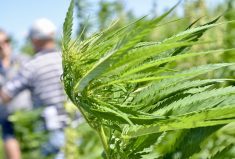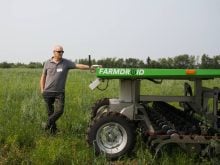The recent article about hemp, and its failure to increase acres and become the next canola, was very thorough on the processor side, but I thought, short on the producer perspective.
We have grown industrial hemp on our farm since it was first declared legal. At that time, because of its connection to marijuana, it fell under the purview of Health Canada. Some of those rules were simple to follow and some were onerous. A licence was required to grow, another to store and yet another for buyers to purchase. The process was stretched out as Health Canada did not have the qualified staff for the undertaking. Hemp could not be seeded until the licence was received from Ottawa.
Health Canada has since improved greatly, but because of the legalization of marijuana, is so busy dealing with that process that industrial hemp is caught up in the regulatory process. There has long been a request for the crop to be moved to Agriculture Canada from Health Canada. We, that is producers, have been told that because the two crops are indistinguishable, how could we separate? Interesting, we grow both rapeseed and canola and although they look the same, and are both brassica crops, somehow the system manages to keep them separate.
Industrial hemp is a relatively low-input crop, but there are very few registered chemicals that can be used. A grower needs to choose a relatively clean field to get the crop started. Once the hemp is six to eight inches tall it is very competitive with weeds as it grows very quickly and the weeds don’t like to be in the shade. So far simple.
Harvest can be a challenge. Most growers have learned how to harvest without modifying the combine. Hemp is indeterminate in seed set, so at harvest there is a mix of green and mature seeds in the combine. Hemp is usually combined at 15 to 20 per cent moisture and sometimes higher — seldom lower. There is usually enough green seed and chaff that, to avoid heating, small loads have to be moved to the dryer at a time. Since the only use for the grain is human consumption, bacterial counts and tests are required after harvest — and again at delivery which can be up to a year later or more.
The next piece of the puzzle is dealing with the processing company which is usually under a contract. Contracts are made for a certain amount of acres, not pounds of product. Hemp yields can be very variable. Under this type of contract the company is expected to accept the total volume. A high yield leads to oversupply. As mentioned in the article, companies don’t always honour the contract conditions. While some companies will contract a delivery window, that too can be ignored.
Hemp does not store well long term. There is no alternative market yet for non-food-quality hemp grain. Work is being done to allow it as animal feed. Currently off-grade hemp can be fed to dogs, cats and horses. There is a small market for birdseed hemp, but cattle, hogs or chickens can’t eat it unless the owner of the animal is also the grower of the hemp.
Farmers will grow the hemp, if the processors want it. So far, hemp has been marketed as a health food, not a healthy food. This favours organically grown grain, and the niche market.
So, the producer needs to first obtain the proper licences from Health Canada, obtain certified seed of a variety that Health Canada approved, and seed the field. Then, provide Health Canada with the GPS co-ordinates of the planted field — in case it wants to test for THC at the grower’s expense, and manage the growth.
The grain then needs to be harvested, dried, and cleaned before it can be delivered to the processing company. The grower then waits for the processor to call for delivery and have the grain tested again for biologicals. The processor will then pick up the seed, and payment will follow within 30 days.
After managing the crop to this stage, for most varieties grown, the straw needs to be removed or burned. This usually occurs in the spring, which adds to the season workload. While there are some companies starting to process fibre, the demand is very little, compared to the supply.
Bottom line — the producer bears all the risk of storage, sometimes for more than 12 months, which can affect cash flows and storage space.
Prices for the grain have not kept up with prices of other crop choices available — and companies have proven in some cases, that the contract isn’t worth the paper it’s written on.
Don Dewar is a longtime hemp grower from the Dauphin area, and former president of the Keystone Agricultural Producers.















